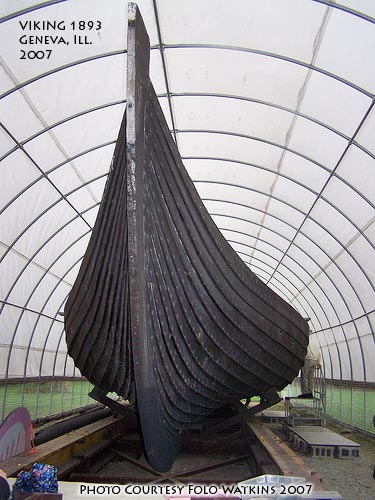
| Vikingskip.com | "Viking" -
Gokstadkopien fra 1893 "Viking" - the Gokstad viking ship replica from 1893. |
| Index | Kvalsund | Oseberg | Gokstad | Tune | Skuldelev 1 knarr | Skuldelev 2 longship | Bryggen ship | Norse ship building | Viking ship classes | Saga ships | Videos |

Viking i plastskuret i Geneva i Illinois, slik det stod 14. okt. 2007. Foto av Folo Watkins.
Viking in its shelter in Geneva,
Illinois Oct. 14th 2007. Photo by mr. Folo Watkins, with
permission.
Watkins is a member of Micel Folcland. See more of mr. Watkin's
fresh photos of Viking.
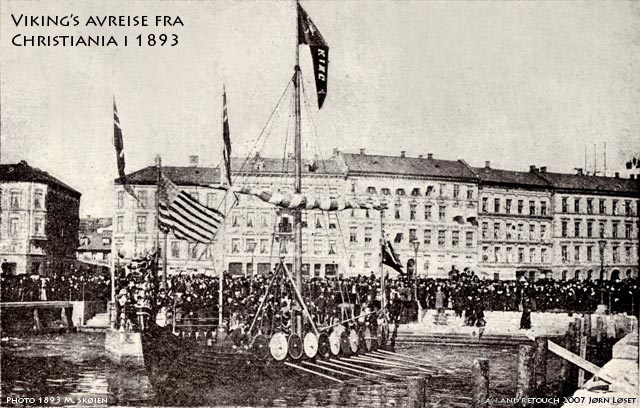
Viking under avreisen fra Honnørbryggen
Christiania (Oslo) in 1893. Merk navnet "Viking" i
vimpelen i masten.
Viking departs from Christiania in Norway in 1893. Note the name
"Viking" in the pennant in the mast.
After photo by M. Skøien 1893. Facsimile from the
book "Vikingefærden", 1895.
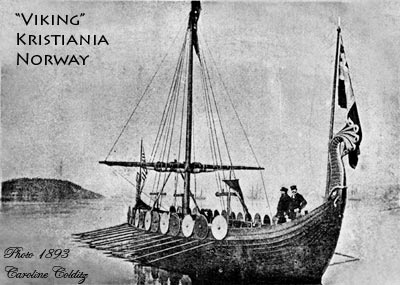 Viking ved Honnørbryggen
i Kristiania. Foto Caroline Colditz. |
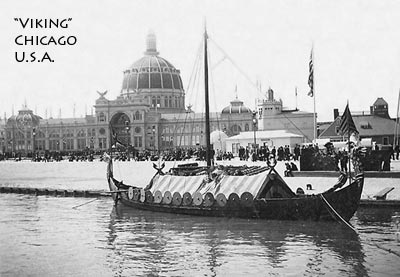 "Viking" ved verdensutstillingen i
Chicago, U.S.A. i 1893. |
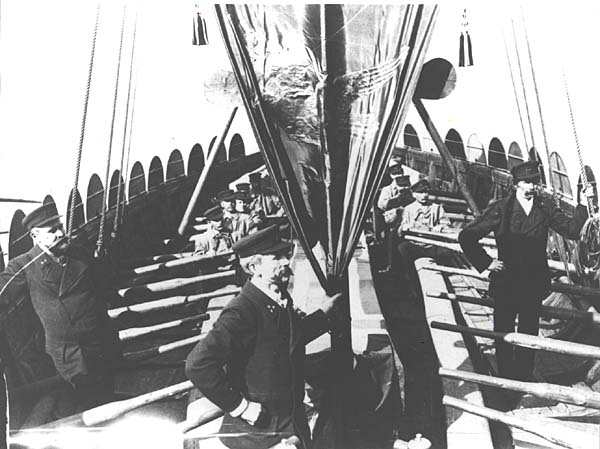
Kaptein Magnus Andersen (midten) ombord på "Viking". Andersen holder banneret med ravnen som har gitt opphav til en del misforståelser om skipets navn.
Capt. Magnus Andersen onboard in 1893. Andersen is holding the banner with a raven, which has lead to the frequent misunderstanding about the name of the vessel.( He's not holding the square sail. )
Copyright expired, photographer unknown.
Viking fra 1893 - verdens første vikingskipskopi
"Viking" var den første kopien av Gokstadskipet som ble bygd etter utgravningene av skipet i Vestfold. Det ble bygget i 1892-93 i Norge som en fullskalakopi i eik ved A/S Framnæs mekaniske verksted i Sandefjord. Opprinnelig ble skipet døpt "Viking". Det er i ettertiden også kjent som "Ravnen" og "the Raven" pga en avbildning av en stor ravn i et banner. Seilet var stripete, og ellers uten dekorasjoner. Men det er en utbredt misforståelse at dette var det opprinnelige navnet. Dessverre har jeg kanskje bidratt til å spre denne selv via denne siden, men vil rette det opp ved å understreke at VIKING er det korrekte navnet.
Skipet ble seilt over nord-Atlanteren fra Norge til Amerika av seilskutekaptein Magnus Anderson i 1893, der skipet ble en attraksjon ved verdensutstillingen i Chicago. Under seilasen beviste skipet vikingskipenes sjødyktighet i åpne havområder til fulle. Skipet forlot Bergen 30. april og ankom Amerika 27 dager senere. Underveis kom skipet ut for hardt vær. Kaptein Anderson la da spesielt merke til hvordan skrogets elastiske egenskaper gjorde at skipet fulgte sjøen i stedet for å butte i mot. Det fleksible skroget er et av vikingskipenes særegne konstruksjonstrekk.
Ved byggingen av "Viking" visste man heller lite om hvordan riggen så ut på de historiske vikingskipene. Man tok derfor utgangspunkt i riggen på nordlandsbåtene og laget et rektangulært råsegl til "Viking". Trolig gav dette "Viking" et råsegl som var for høyt og smalt. Ved utgravningene av Osebergskipet ble det funnet trestenger som antas å være råa til Osebergskipet. Disse funnene indikerer at Gokstadskipet opprinnelig hadde et lavere og bredere segl enn det som ble laget til "Viking".
Utrolig nok eksisterer "Viking" ennå, men det frister en kummerlig tilværelse bortstuet ikke langt fra Chicago. Skipet er i Chicago kommune sitt eie gjennom Chicago parkvesen. I mange år skal skipet ha vært lagret under relativt gode forhold under tak i Lincoln Park i Chicago. På 1970-tallet ble skipet flyttet til Good Templar Park i Geneva litt vest for Chicago, Illinois. Etter dette ble lagringsforholdene vesentlig forringet. Skipet stod i mange år i et midlertidig lager der overdekningen med tiden har blåst bort. Slikt det stod åpent for vær og vind, må en anta at skipet er utsatt for råte, oppsprekking og deformering.
Med tanke på hvilken verdi dette fartøyet har sett i en historisk sammenheng er dette intet mindre enn en skam at dette skipet forvitrer! Skipet var det første vikingskipet som krysset Atlanteren siden vikingtiden, og har en unik posisjon som bindeledd mellom vikingtid og nåtid. Det er et historisk bevis på at vikingene virkelig hadde gode nok skip til å krysse verdenshavene 1000 år tidligere. I sin samtid må dette ha vakt stor oppsikt og ha hatt stor symbolverdi for nasjonalfølelsen i Norge der vi stod foran en gryende løsrivingsprosess fra den påtvungne unionen med Sverige. For 5 millioner norskættede amerikanere vil jeg tro at dette skipet også vil stå som et helt spesielt symbol på den store utvandringen fra Norge til Amerika.
Fra dansk-amerikanske Peter Orum har jeg fått noen (for meg) nye opplysninger om Viking. Orum er mannen som generøst har sponset plastoverdekningen av Viking i de siste årene, og er en kar som har fulgt godt med. Uten hans sponsing ville Viking ha vært i en langt dårligere forfatning.
Han har oversendt meg en perm med en sammenfatning av hva som har skjedd rundt Viking de senere årene. Blant annet har han lagt ved dokumentasjon på at Viking ble undersøkt grundig av Søren Vadstrup i 1999. Vadstrup gikk over hele skipet og laget en detaljert tilstandsbeskrivelse, inkludert et kostnadsoverslag for konservering. Restaurering til seilbar stand faller jo langt dyrere. Han anslår arbeidet på stedet til å utgjøre 90 arbeidsdager for to mann, altså 1440 timer. I tillegg kommer materialkjøp og produksjon av deler som må/bør erstattes, på mellom 0,5 og 1 mill danske (1999) kroner. Nå har kursen på US dollar falt mye siden 1999, så kostnadene i dag er kanskje omlag det samme eller litt høyere. Vadstrup anbefaler at arbeidet gjøres av amerikanske håndverkere, men helst under veiledning av skandinaver.I Februar 2007 ble Viking tatt inn på en liste over truede kulturminnesmerker i delstaten Illinois - "Top 10 Endangered Landmarks in Illinois". Dette er svært viktig, for denne offisielle listingen gir Viking en helt annen status enn tidligere. I tillegg har den skandinavisk-amerkikanske foreningen Scandinavian American Council, som fra 1995 var formell eier av Viking, opphørt å eksistere. Chicago kommune ved Parkvesenet har anerkjent at eierskapet nå har gått tilbake til kommunen. Chicago eier altså Viking per 2007, og uklarhetene rundt eierskapet er borte.
Høsten 2007 pågikk det en viktig kampanje for restaurering av kulturminnesmerkene i Illinois. En global industriell sponsor stilte opp med 1 million $ til en avstemningskonkurranse om hvilke ti prosjekt som skulle få midler til restaurering. Viking varr inne på denne listen som et av 25 utvalgte prosjekter. Viking kom på andreplass i avstemningen, ett stor innsats både i USA og til dels i Norge for å stemme fram Viking. Premien er på 52000 USD som er tilstrekkelig til å få Viking stabilisert.
14. nov. 2007: Viking får 52.000 $ !
Det ble kunngjort den 14.11.07 i USA at Viking virkelig får midler til restaurering. Beløpet er 52.000 USD, som er 100% av summen det ble søkt om for innledende restaueringsarbeider. Kampanjen for å gi stemmer til Viking, gav dermed full uttelling. Alle som stemte, har en liten del i dette.
Midlene vil i første omgang gå til å konservere skroget og en ny ramme som skipet kan hvile på. Den gamle rammen gir for ujevn støtte, slik at skroget slår seg og bordgangene sprekker. Særlig er bordene med årehullene dårlige. Jeg mener at dette arbeidet bør ledes av norske båtbyggere med erfaring fra tilsvarende skip, men i denne saken er jeg naturligvis ikke objektiv. På sikt er det viktig at amerikanerne opparbeider seg kompetanse slik at de selv kan vedlikeholde skipet. Det avgjørende nå er at Viking virkelig har fått fornyet status og oppmerksomhet, og nå endelig midler til å sette i gang. Dette kan være det avgjørende vendepunktet for å berge skipet for ettertiden.Jørn
Oppdatering 23. juni 2008: restaureringen av Viking er i gang! Sjekk ut den amerikanske nettsiden Vikingship.us for å se framgangen i prosjektet. Det er lokale krefter i Geneva som driver prosjektet, i samarbeid med Chicago Park District.
Jørn Olav Løset
"Viking" - the Gokstad ship replica from 1893
Aka. the Chicago Viking ship, and the Geneva Viking ship
In 1880 a viking ship was unearthed from a burial mound at the Gokstad farm in Sandefjord, Norway. It turned out that the ship was amazingly well preserved as it had been buried in blue clay, which prevented it from rotting over the 1000 years since its burial. Only the stem and stern was rotted, so it was possible for archaeologists to uncover and restore the entire ship with great accuracy. The ship was 23,5 m long and with a beam of 5 m. This ship is world famous today, and known as the Gokstad ship. It is exhibited in the Viking ship museum in Oslo, and is one of Norway's greatest attractions and historical treasures. The ship is a heritage of global value.
The idea of a replica
I 1889 an american General (identity unknown to me) captured the idea of building a replica of the Gokstad ship. This was reported in Bergens Tidende, one of Norway's major newspapers. The idea of a viking ship replica was born, but still not realized. In 1892 a rumour spread to Norway that a replica of Christopher Columbus' ship Santa Maria was to be displayed at The World's Columbian Exposition in Chicago, USA, the following year. The exposition opened at 10.12.1892, with great celebrations of the 400-year anniversary of Columbus' discovery. A group of resourceful people in Norway saw this as an opportunity to challenge the common view of Columbus being the first european to land in America, by proving that the vikings really had ships that were capable of crossing the Atlantic 500 years earlier than Columbus. The norse and icelandic sagas told about the Vinland discoveries by Bjarni Herjolfson and Leiv Eiriksson around year 1000, nearly half a milennium before Columbus. In Norway the sagas were regarded to be true, but the archaeological evidences still lacked at that time. The group formed a comittee for the project and editor Magnus Andersen was promoted to be the leader, with formal rank as naval captain. Now that the Gokstad ship was found and examined, Andersen had a historical correct ship to replicate. He wanted to sail it from Norway via Newfoundland to the fair in Chicago. A pretty daring project!
The construction
On the May 17 1892 the group started a national campaign to raise the needed fund for building a new ship. During summer 12000 norwegian kroner was collected from all over Norway, and in the fall 1892 the worlds first viking ship replica ever started to take shape at the Framnæs Shipyard in Sandefjord. In charge of the construction was Chr. Christensen and Ole Wegger from Sandefjord and carpenter Carlsen from Horten.
The materials needed were hard to come by, as the dimensions of the original keel and the mastfish were taken from oak logs of unusual dimensions. The 17 m long keel required a strait oak log from a 25 meter tall tree. While such trees existed in Norway in the viking age, this log now had to be imported from Canada. The rest of the ship was made from local oak trees. The ship was built in a shed at Framnes shipyard and no strangers were allowed entrance to the site during the construction. Unfortunately, this included photographers, so no photos were taken at this stage.Sea launch and naming
In the winter of 1893 the ship was finished. On February 4. the ship was sea launched in Sandefjord. The ship slided graciously into the icy cold water before 8000 spectators. It was solemnly named with these words in the ceremony:
- VIKING er ditt navn. ( - VIKING is your name. )
When one investigate the sources, there is no doubt that Viking is the correct name of the ship. There is a widespread misunderstanding that the ship initially was named The Raven, and later renamed Viking after its arrival in USA. Its erronymous nickname derives from a depicted raven decorating a red pennant that was used on the ship. This pennant is briefly visible on some of the images from 1893. However the ship also carried a long tapered pennant in the top of the mast with the text "Viking". My source about the name Viking is from the Framnæs Shipyard itself. (See list of ships, no 27). hat it must have felt like when the Viking slid into the water and helmsman Andersen could grasp the tiller for the first time, one can only imagine. It must have been an unforgettable proud moment for everyone present to see the first viking ship on a fjord for real in almost 1000 years. Bear in mind that until the excavations of the Gokstad ship no one actually knew exactly how the viking ships looked like. The Viking now represented the first recreated vision of the ancient ships in modern times ever. I can add that the Viking from what I have seen in several photos still looks like it was built very close to the original Gokstad ship. They really look like sister ships, despite the millennium between them.
The trans-Atlantic crossing
Later that spring Viking set sail from Oslo to Bergen, and started on its voyage across the North Atlantic on April 30. It sailed from Norway via Scotland to Bacalao, Newfoundland in only 28 days. During the trip, Andersen took notes of how the ship acted under rough weather conditions. The ship performed well, and could hold a cruising speed of about 10 knots. He also noted how the hull flexed with the waves, unlike the stiff hulls of modern sailing ships. Viking arrived in New York after racing against american schoonerts down the coasts of Nova Scotia and Massachusetts. Andersen rigged the Viking with more sails than the single square sail on this prestiguos dash, and outpaced the 1000 year newer types of sailing ships. They were simply left behind. This proved for real that the vikings had reached near perfection in ship design.
Viking's route from NY to Chicago
From New York capt. Andersen followed a rare route along several lakes and rivers to reach Chicago. Its shallow draught permitted it to navigate along a waterway were modern ships cannot follow. This is Viking's route from New York to Chicago as described in the book Vikingefærden. The distance is 1500 english miles:
New York departure on monday morning June 26. 1893
Junkers
West point
Newburgh arrival at tuesday June 27. at 09.00, great celebrations
Albany
Troy
The Erie canal, at the time 400 eng. miles and 71 locks in all, start at wednesday June 28. at 14.00, mast lowered and the dragon head taken off because of many low bridges across the canal. The draught was only 6 feet. The clearance in width was only 6 inches! The locks were 17 feet 6 inches wide, while the ship was 17 feet. The mattresses onboard were used as fenders. Erie map.Rochester, towed by steamer "Netty".
Lock 30, collision between Netty and another boat. Netty sinks in 5 minutes. Viking had to be pulled by men and horses to the next town.
Little Falls, lock 45, a long stop, towed by the little steamer "Hon. Titus Sheard"
Frankfort, lock 45, thursday June 29. at 23.00
Utica
Rome
Canastota, short stop to fix the towing boat
Syracuse, lock 47, long stop and party at a hotel friday June 30.
Clyde, lock 53, capt. Andersen nearly drowns during a bath in the canal in the afternoon that saturday
Lyons
Rochester, official reception, but the Viking is one day behind shedule
Albion, sunday 2. July at 14.00, thousands of spectators
Lockport, passing lock 71 at sunday July 1. at 22.00Buffalo arrival monday morning July 3. at 04.00 (two days after the plan), mast raised again, departure at 16.00, towed by the damper "Cascade"
Port Colborn at Lake Erie
Cleveland July 4., official receptions, sightseeings and dinner at night
Detroit river wednesday July 5.
Detroit July 6.
Lake Huron July 7., towed at 14 knots by 3000 ton steamer "Albano" from Western Transit Co., Albano sunk a few days later with 6 men onboard
Old Mackinaw same day at 14.00 in bad weather
Lake Michigan, entered July 8. in the evening
Milwaukee Breackwater July 9. at 02.00, anchoring in bad weather
Milwaukee departure monday July 10. at 14.00, towed by "Andy Johnson"
Racine arrival in the afternoon tuesday July 11., great official celebrations
Evanston wednesday July 12. at 11.00, party at night, ship cleaned in the morning
Last leg to Chicago in convoy with more than 50 steamboats.
Chicago arrival July 12. 1893, parade along Lincoln Park to Jackson Park, at least 100000 spectators
Chicago Columbian Expo arrival in the afternoon the same day.
Viking in the Erie Canal, nearby lock 18.
"Viking" at the World fair in Chicago.
The Chicago World Fair
Viking arrived the Columbian Exposition as planned, and immediately became a great attraction. Its arrival created major headlines in newspapers all over the world. Hundreds of thousands visitors saw the ship, and it is not an overstatement that it stole the show from the columbian ships. After the voayge of Viking there was no longer any doubt that the vikings had vessels capable of reaching North America.
After the fair, the so far successful story changes dramaticly. In 1894 Andersen donated Viking to the city of Chigago. The formal owner now became the Chicago Park District. The ship was for some decades exhibited at the Museum of Science and Industry in Chicago, which was built as a part of the WCE in 1892. But in the 1920s it was relocated to Lincoln Park. The conditions for storage here changed and in periods the ship was exposed to weather. The ship began to detoriate. Several attempts to restore the ship were made, but no permanent solutions were established.
In 1995 an organisation named Scandinavian American Council (SAC) took over the ownership for a symbolic amount of 1 $. The plan was to find a better home for the ship. It was moved to Good Templar Park in the city of Geneva, some 60 km west of Chicago. This is were the Viking is located today. Its home is a canopy shelter, which is not strong enough to keep winds from ripping it from time to time. Despite the good intentions to save Viking, the SAC did not find a permanent solution before the council seized to exist in 2006. The company Midwest Groundcover and Midwest Trading led by ex-dane Peter Orum has paid for replacing the canopy during the years in Genova. But fighting weather every year to high expences is not a permanent solution. In 2007 Viking was listed as an endangered landmark of Illionois, which was a turning point to the better.
Nov. 14th 2007: Viking was granted 52.000 $ for preservation!
Preservation grants go to Viking Ship (ext. link)Viking received enough votes to be ranked second out of 25 projects in the voting at Partnersinpreservation.com. This unique ship qualified to receive financial support for preservation from a total fund of 1 million US $. The fundings were to be split between the 10 top contestants.
The stabilization of Viking is now in progress! Check out the American Viking project page "Friends of the Viking ship" for the latest news: Vikingship.us.
You can help them out by donating a few bucks to replace the old rusted rivets with new ones. Viking has some 6000 rivets to take care of:
Exhibition in the future
An important issue is where and how to exhibit the Viking after the stabilization of Viking is completed. The choices here are many. I guess that the Chigago Park District has to sort this out together with the organisations in the US who are involved in the preservation of the ship. The cost of exhibition is of course depending on how one choose to do it. Restoring the ship back to seaworthy condition is regarded as unrealistic as the expences will be too high, at least equal to building a new ship. The initial goal is to stabilized the ship from further detoriation.
The ship has potential to be a be a tremendous tourist attraction in the future. It would be a great way to spread knowledge about sailing, Norse and north European culture, and to tell the dramatic story about this particular ship. The ship could act as a unique source for histoy lessons for school kids and students. After all this ship was the first viking ship replica in modern times ever, and of course the first viking ship to cross the Atlantic Ocean in nearly 1000 years.
Jørn Olav Løset
Try to see this in stereo. Let the images float together and focus.
The Viking in 1893. Photographer unknown. Copyright expired due to age.Mer om "Viking" / More about "Viking":
The 1893 scrapbook of capt. Magnus Andersen (ext. link)
The Daily Herald: Viking ship renovation begins Jun. 21th 2008.
The Beacon News: Preservation grants go to Viking Ship Nov. 14th 2007
Examination of Viking: http://www.vikingship.us/preservation.htm Nov. 10th 2007
The Geneva Sun: Funds might still be available to restore Geneva's old ship Oct. 17. 2007http://home.att.net/~viking.1893/
http://www.hydepark.org/parks/jpac/jpkhistoryandfair.htm
http://washingtonmo.net/1893/viking.htm
http://www.nrk.no/nyheter/kultur/2993463.html - artikkel fra 2003.
http://www.swedishday.net/viking_ship.html - bildeserie fra 2006
http://www.suburbanchicagonews.com/beaconnews/news/279131,2_1_AU 1_VIKING_S1.article - artikkel fra 1. mars 2007
http://www.landmarks.org/ten_10.htm - Viking fikk vinteren 2007 status som et av topp 10 truede kulturminnesmerker i Illinois.Kim Peart's site, Tasmania: http://web.mac.com/kim.peart/iWeb/Site/Save_the_Viking.html
Literature and sources:
Vikingefærden, Capt. Magnus Andersen, 1895, Kristiania (Oslo).
Framnæs verft, bilde av Viking: http://www.lardex.net/framnesmekverksted/vanligebilder/1893VIKING.htm
Framnæs verft skrev i mai 2007 en ny artikkel om Viking. Den kan du lese her >>. Skribent trolig Kristoffer Wegger(?).
"Viking, from Norway to America", Rasmus Rasmussen (besetningsmedlem/crew member).
"A/S Framnæs mek. Verksted 1848 - 1948", Hans S.I. Bogen, Dreyers forlag, Oslo. Utdrag tilsendt meg, med stor takk til Kristoffer Wegger.Note: de eldste fotografiene her er over 100 år gamle og er etter åndsverkloven derfor ikke lenger fredet. Fotografen(e) er også ukjent for meg.

| Copyright 2004 Jørn Olav Løset. E-mail: | joeolavl | @ | online.no |